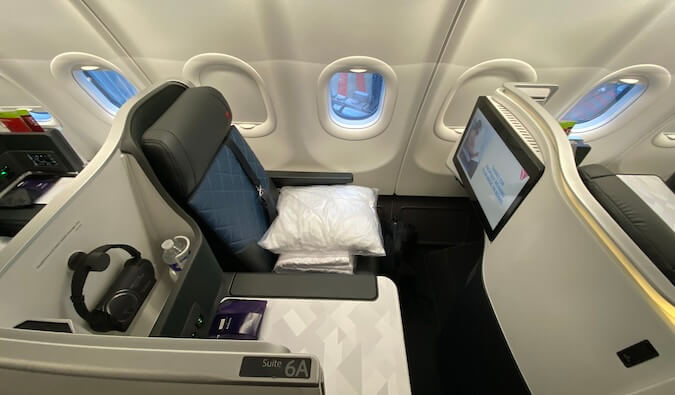The Auto-Resistance on Peloton's Bike+ Might Make the Extra Cost Worth It

We may earn a commission from links on this page.
For two weeks, I've been testing out a Bike+, the upgraded version of Peloton's famous Bike, all so I can write reviews of it. Since I've been an avid rider of my regular Peloton Bike for four years, I've been paying attention to any differences I notice in the performance of the two stationary cycles—especially any differences that make their $1,000 price difference worthwhile.
The feature I was most excited to test out, which my Bike does not have, is auto-resistance. With that, the Bike+ automatically adjusts the rider's resistance for them, setting it within the boundaries of the resistance called for by a instructor at any given point during a virtual class.
How does the Bike+'s auto-resistance work?
When you're taking an on-demand cycling class or completing a Power Zone workout, the Bike+ will adjust your resistance so that you're somewhere in between the numbers the instructor is calling for. So, if your instructor says your resistance should be between 40 and 60, the auto-resistance feature will plop you somewhere in the middle of those values; you don't have to spin the resistance knob yourself.
The auto-resistance is pretty smart, in my experience. When I did a nighttime workout after a day full of teaching spin class, doing other Peloton rides, and walking around in the heat, I wasn't feeling particularly energetic or even athletic. The auto-resistance caught on to that and adjusted my resistance to the lower end of the spectrum the instructor was calling for.
Overall, it just makes taking a class a little easier because you don't need to be constantly reaching down to adjust the knob. You can focus only on your cadence (and form, breathing, output, and hydration, of course) without having to stay on top of your resistance, too.
How to enable (or disable) auto-resistance on the Bike+
Enabling and disabling auto-resistance can be done before or during a workout. When you select a workout to complete on your device's touchscreen, you'll see a pop-up window that outlines a few details like when the class first aired, who's teaching it, and what the class is called. You'll also see a button that says "Auto-Resistance [Off/On]," which will, obviously, signal to you that the feature is on or off before the class starts.

Once the class begins, you'll see a small lock icon next to the resistance on the lower right half of the screen. You can tap it to unlock it (turn auto-resistance off) or lock it (turn it on). I've noticed that if I start a workout with it off, then toggle it on, the auto-resistance tends to stick near whatever I was doing on my own. For instance, this morning, I started a class with it off, but was only riding about five above the lowest recommended resistance. When the instructor said resistance should be between 30 and 45, I was only doing 35. (I'm teaching classes later tonight, so I didn't feel I needed to over-exert myself! Leave me alone!) When I toggled auto-resistance on by tapping the lock icon, it consistently kept me at about five over the lowest recommended resistance level.
You can make manual adjustments while you ride, even if auto-resistance is turned on. At one point this morning, I did crank my resistance knob up to the highest recommended setting for a while. When the instructor told riders to lower their resistance a few minutes later, auto-resistance kicked in again and put me on a lower one with no issue, though it was, again, near the upper limits of the recommended range, since that's how I had set it manually.
Is this feature worth an extra $1,000?
The Peloton Bike+ is about $1,000 more than the regular Bike and will run you $2,495—with this auto-resistance feature being one of the main selling points.
I did appreciate that the tech is smarter that I assumed it would be and was able to adjust my resistance not only to the middle of the recommended resistance range, but lower or higher within it, depending on how I am performing. I also appreciate that it can be manually overridden mid-class and even disabled completely if you're not into it. It's great to be able to ride without having to constantly think about making adjustments, plus I find it a little motivating. When I'm in charge of the resistance (like I have been for four years riding my Bike), I can slack a little if I want to, you know? Who's going to stop me if I choose to set my resistance to the absolute lowest recommended number? With auto-resistance, I feel just a little guilt if I consider manually overriding it to make my workout easier. More often than not, of course, I find that having my resistance set to the middle or higher end of the recommended spectrum is completely doable; I'm lazy, not incapable. The auto-resistance helps me stop being quite so lazy, which is a little counterintuitive, since the machine is doing the work of messing with the knob for me.
Still, If you don't mind reaching down and spinning that knob, if you don't think you'd find it particularly motivating to see your resistance set in the middle of the recommended range, or if you don't even think you'd use this feature, it may not be worth an extra grand. There are some other differences between the two bikes that could push you over the edge and make you want to spend that extra dough, but don't forget that the membership that allows you to take the classes will cost you $44 per month forever, even after you've paid off the Bike, so that's another expense to consider.
Overall, I genuinely like this feature, but when I've disabled it or gone back to my trusty Bike after using it, I haven't really missed it. It's unique, cool, and useful, but it's not necessary. Coupled with the other improvements in the Bike+, however, it makes a strong case for an upgrade: The Bike+ has better speakers, a bigger screen, simpler adjustment knobs to change seat and screen height, and overall better performance while running Peloton's proprietary software. All of that combined with the extraordinarily efficient auto-resistance makes for a better machine. If you're looking to upgrade from your existing Bike to a Bike+, consider selling your older model on Peloton's own resale site, which will get you some cash plus a few hundred off your Bike+ purchase.
What's Your Reaction?
 Like
0
Like
0
 Dislike
0
Dislike
0
 Love
0
Love
0
 Funny
0
Funny
0
 Angry
0
Angry
0
 Sad
0
Sad
0
 Wow
0
Wow
0










































